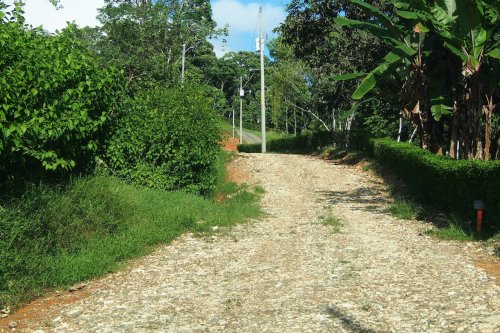By: Ron Snell.
Directions for finding a property in Southern Costa Rica almost always start off something like this: “Drive down the coastal highway until you see this landmark, then turn left and go up the mountain.”
In a place where almost no roads are paved once you leave the coastal highway, that bit about going up the mountain can be rather intimidating to the uninitiated. Many a newcomer has asked us, “Is this road even passable in the rainy season?
The short answer is yes, but of course it’s a longer answer than that.
Most roads were cut into clay hillsides and as almost everyone knows, clay is the perfect soil for slip and slides. Left on its own in the rain, it would provide about as much traction as icy
pavement in Northern climates. Get a steep enough hill and you could create a superb tropical amusement park selling tickets to let people slide down it on their bare backs in the rain. I should know—I used to do that as a kid in Peru.
The good news is that layers and layers of rock or gravel have been added and packed into the roads over the years, creating a base that holds up well in the rains. Soft spots may emerge here and there, or extra heavy traffic may temporarily damage roads if they are too wet, but by and large there are few reports in the area about people not being able to go where they want even in the heart of rainy season.
Counterintuitively, our roads can actually get more dangerous in the dry season than in the
rainy season. This is because when the roads are wet, the clay acts as a sort of mortar holding all of the rocky gravel in place. Then when the roads dry out, the soil turns into dust, the rocks start rolling around, and now you are driving on ball bearings.
Most neighborhoods therefore do some serious road maintenance twice a year: once toward
the end of the rainy season in December, and once just after the end of the dry season in May.
Routine maintenance involves bringing in the appropriate truckloads of fresh surface material, a road grader and a packer. When it’s done, the roads are safe and scenic.
So… generally speaking the roads are not of great concern when you are looking at properties.
You will get used to them very quickly and not give them a second thought.However, there are a couple of things to always keep in mind when driving up and down our roads:
1. Take your time. Unless you have a genuine emergency, there is no reason to drive fast. Speed is the greatest contributor to torn up roads, especially in the dry season. In addition, your ability to stop quickly is radically affected by the condition of the road. Right around the corner there may be a pedestrian, a cute animal, or a fallen tree. You don’t want to hit any of those.
2. Use 4-wheel drive. Depending on the road and the season, many roads don’t require 4 WD, but you will save both the road and your tires by using it anyway. The more tires you have pulling, the less likely it is that you will spin and tear up the road surface.
3. When you purchase property in rural Costa Rica, always ask about road fees. Most of our
neighborhoods ask residents to contribute annually to road maintenance. It’s not legally
required, but doing so speaks volumes about your attitude toward community and your desire to maintain your property’s value, your safety and your enjoyment as you come and go. It’s a small price to pay for living in this beautiful place.






